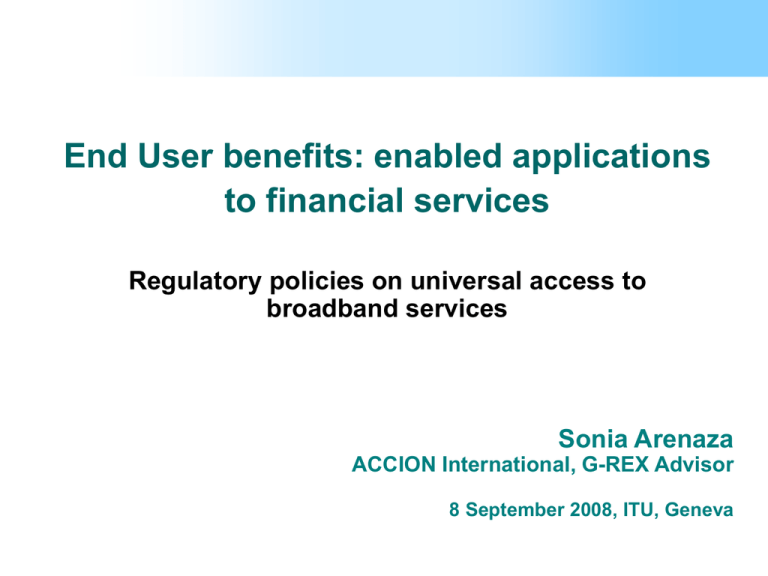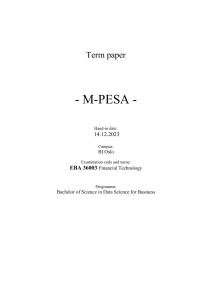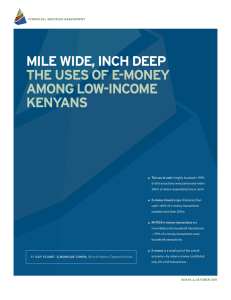End User benefits: enabled applications to financial services broadband services
advertisement

End User benefits: enabled applications to financial services Regulatory policies on universal access to broadband services Sonia Arenaza ACCION International, G-REX Advisor 8 September 2008, ITU, Geneva Agenda Some facts Why Mobile Banking? m-payment m-banking Some experiences Challenges Conclusions Some Facts Between 2007 and 2012, the number of mobile subscriptions will increase from 3.3 billion to 4.7 billion. (Pyramid Research) Africa, Middle East, and Asia biggest subscriber gains Western and Eastern Europe subscriber base will shrink Modern communications bring to an economy better productivity performance. (Wold Bank) A 10% in cell phone penetration gives a 0.6% in GDP growth Mobile payment is expected to reach 33 million users in 2008 and growth 300% in 2011. (Gartner) Some Facts The global migratory trend will increase; current remittances market reaches $318bn, and close to $600bn with informal transactions. In the next five years, it will reach at least $1 trillion. (Wold Bank) The lack of copper wire to the home and challenging geography is making wireless delivery of voice and data the most promising option. As teledensity grows voice is going to become a commodity. Focus is over data; voice and data, along with all related and converged devices. VoIP is bringing down tariffs in those countries where it has been legalized. Why mobile banking? Cell phone penetration is growing faster than traditional banking infrastructure such as branches, ATMs, POS at stores, internet penetration. Banking via cell phones allows lower transaction costs, people in rural and remote areas find it more accessible and convenient than traveling far or standing in line. There is an opportunity to increase market share, lower income and mass market clients. BANKING the UN-BANKED => rural coverage, the extensive use of mobile phones, and technology makes people more bankable (leapfrog to m-banking) m-payment m-payment; paying for a product or service using mobile technology, as for example merchandise purchase, monthly bills, money tansfers. Asia/Pacific has 85% of m-payment users. Models on basis of payment: Bank Account based, Credit Card based, and Telecommunication Company billing based Emerging mkts Developed mkts few payment options extension of existing services Technologies GSM mobile phones send/receive information through SMS, USSD (unstructured supplementary services delivery), WAP/GPRS (wireless application protocol/ general packet radio service) Phone-based application developed in J2ME java for GSM and BREW (binary runtime environment for wireless) for CDMA; SIM based application NFC (near field communication) as a fusion between RFID and a mobile phone Characteristics: simplicity and usability, universality, interoperability, security, privacy and trust, cost, speed, cross border payments. m-banking Transformational branchless banking • Use of ICT and nonbank retail channels to reduce cost of delivering financial services to clients beyond the reach of traditional banking • Besides mobile phones, other approaches can be ‘correspondents banks’ • Customer could deposit/withdraw cash through a mobile operator’s airtime-resale agent Types of branchless banking: additive or transformative Technologies: mobile phones and POS devices It can be combined with microfinance loans, providing access to credit and establishing a credit history Allows to lower remittances transaction costs (cross-border and domestic) by sending money to other people via cell phones Use of mobile phone technology impacts microfinance improving productivity, efficiency, and accessibility. Some experiences M-PESA, Kenya SMART money, Philippines Globe G-cash, Philippines MTN Banking, South Africa Wizzit, South Africa Paym8, South Africa Xac Bank, Mongolia CELPAY, Zambia and DR Congo Text-n-pay, Ghana Equity bank with EAZZY 24/7, Kenya DoCoMo, Japan Other Xam Marse (know your market), Senegal GSMA’s mobile money transfer program Some experiences M-PESA Joint venture between Safaricom and Vodafone Money transfer by SMS (buy/sell M-PESA e-money, send money, and buy prepaid airtime) Business model based upon high volumes of low value transactions. Pay as you go charging model Vodafone customers in UK can send money to Kenya e-money backed by real money in a conventional bank account, M-PESA records to whom money belongs Some experiences CELPAY Financial Services Company operating in Zambia and DR Congo. Partnership with banks and network operators Money is taken from deposits accounts, no credit e-access to a bank account through mobile phone, internet, and POS Real-time account update Funds in the accounts belongs to Celpay-subscribers and merchants, not to Celpay Some experiences G-CASH Partnership with Globe Telecom (leading mobile phone providers in Philippines) Micropayments over a mobile phone. Text-based transactions e.g. deposit/withdraw money, loan payment/disbursement, send/receive money, pay bills All transactions are recorded in an electronic ledger in Globe Limits in amount of money transacted per period Challenges Convergence of telecommunications and financial services Proportionate regulatory policy Guarantee confidentiality, integrity, non-repudiation, and authentication Interoperability, ability for customers of competing financial service providers to transact business with each other Customers’ receptive attitude and trust, as well as illiteracy and remote location ¿ How to encourage access to mobile banking limiting money laundering, credit exposure? Challenges Develop cohesive standards Partnership between financial institutions, regulatory bodies, and mobile network operators Build a business model around financial services e.g. remittances, wage payments, government social benefits that clients could use as history and fund to access to other financial services such as savings, transaction bank account and ultimately credits. ¿Telecom operators moving into the data market and IT players becoming phone operators”? Conclusions The mobile handset is becoming the key enabler for financial services. It allows financial inclusion Financial inclusion will allow bringing people into the formal economy and beginning to access to basic services Mobile financial services brings opportunities for customers (accessibility, convenience, security) and businesses (revenues, more customers, low cost services) Increasing demand for the provision of internet, voice, and television, all in the same package (mobile broadband internet) There will not be a one-size-fits-all solution End User benefits: enabled applications to financial services Regulatory policies on universal access to broadband services Sonia Arenaza sarenaza@accion.org ACCION International, G-REX Advisor 8 September 2008, ITU, Geneva





